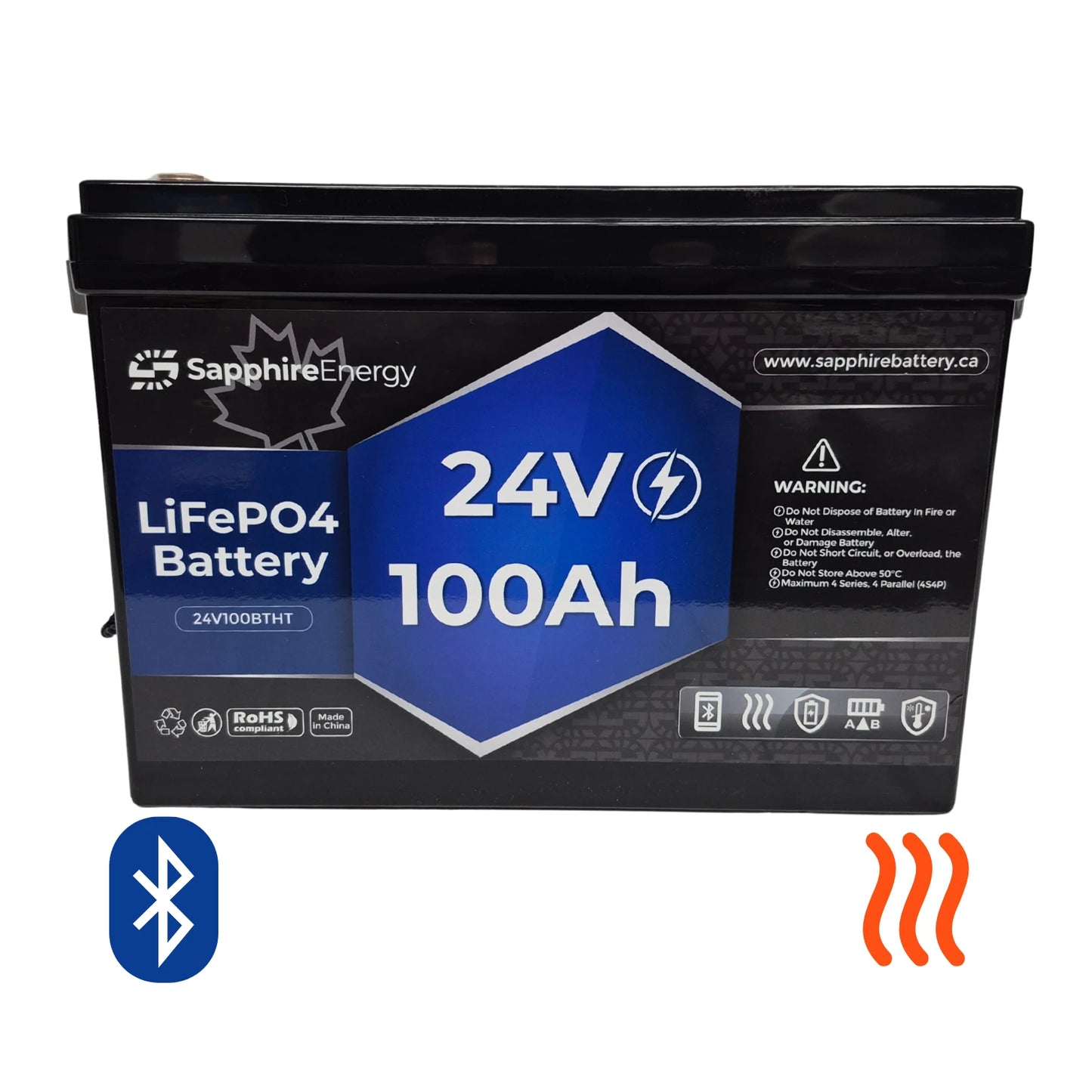
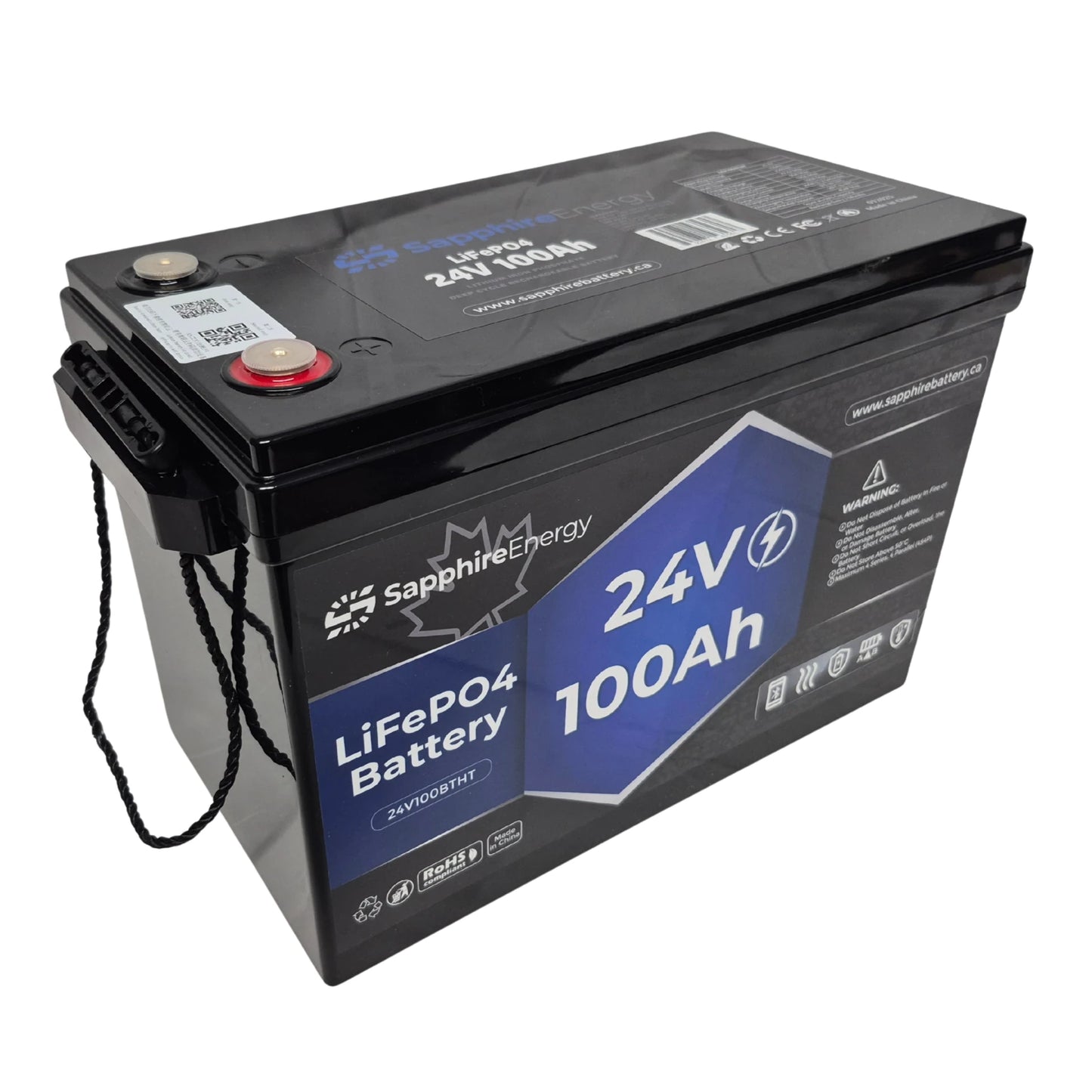
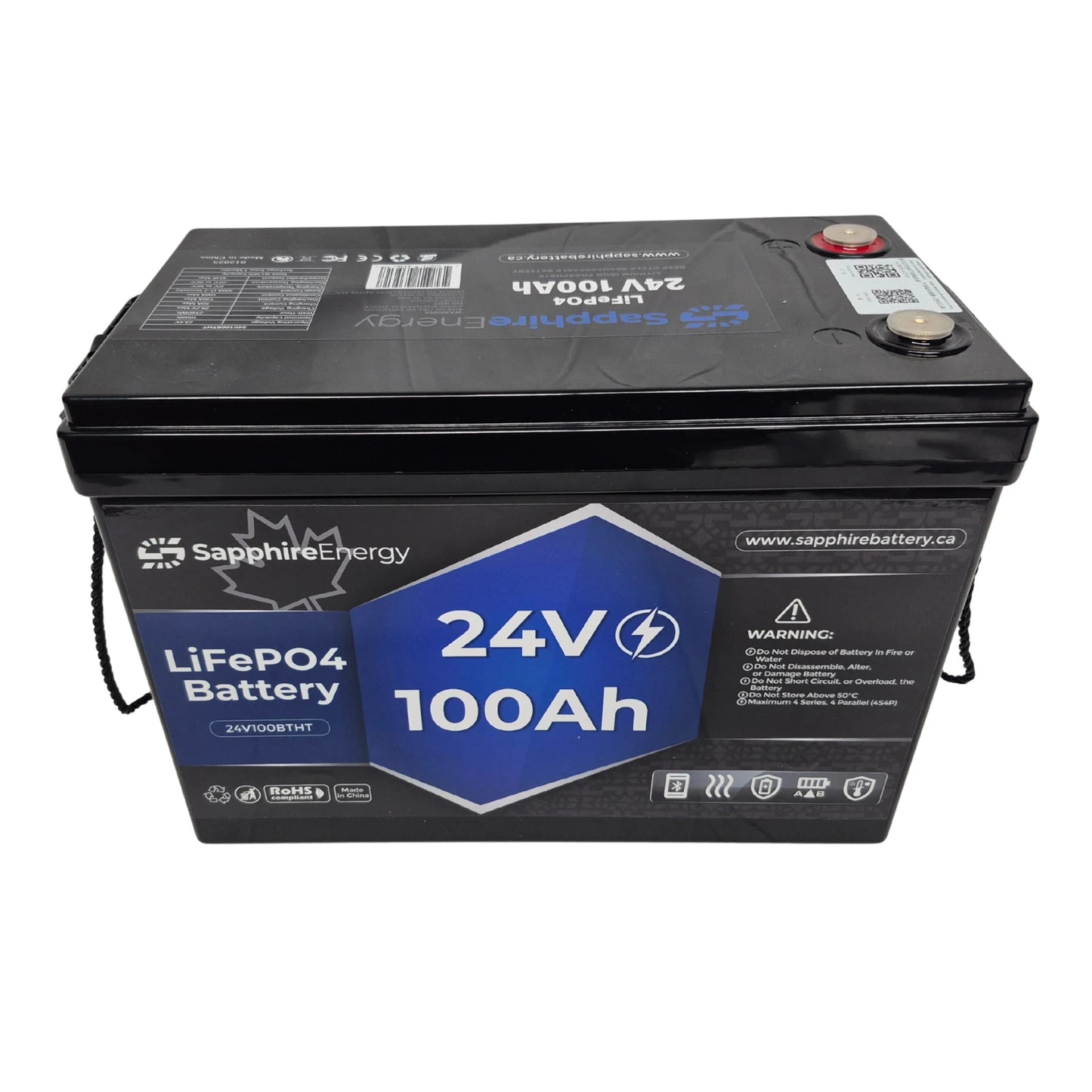
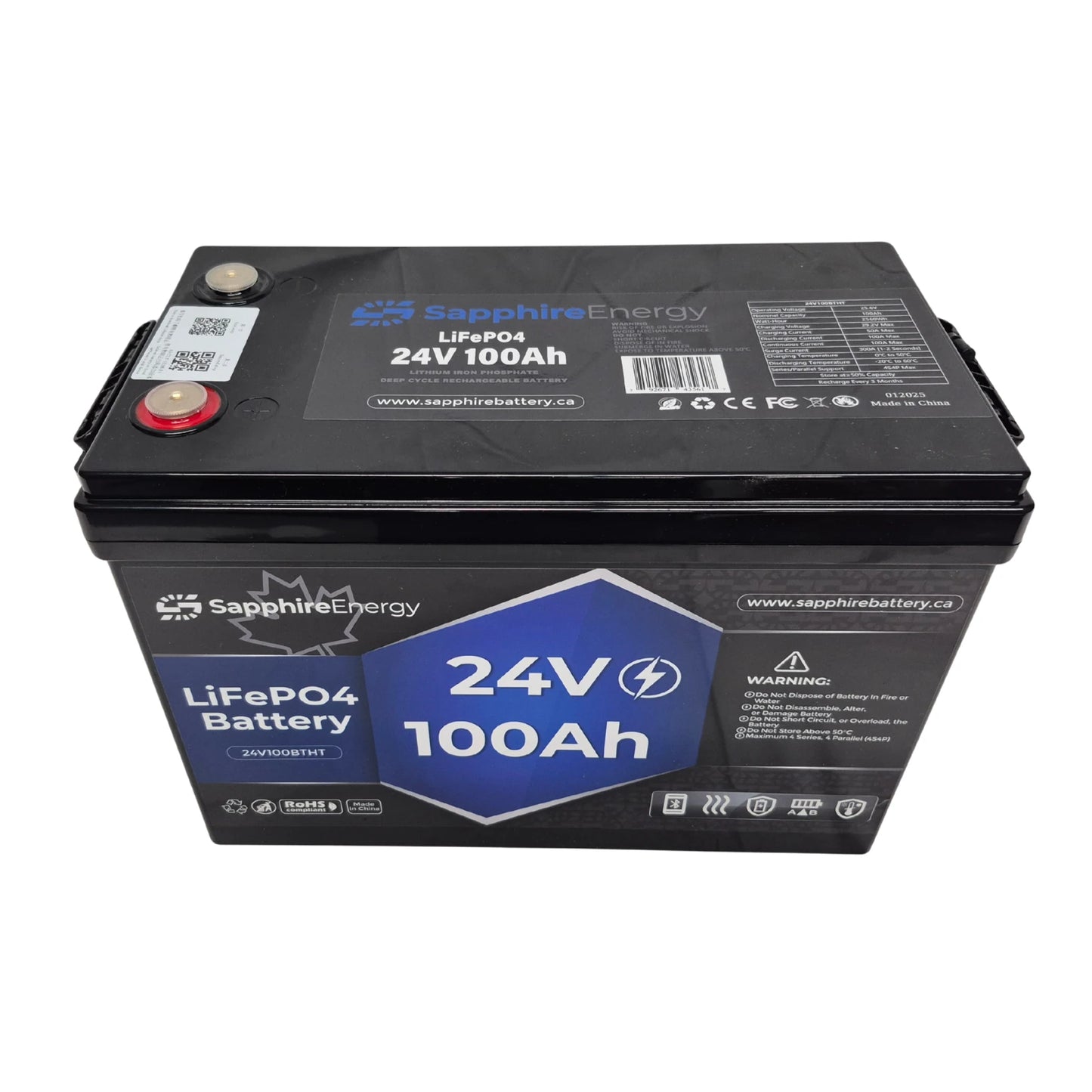
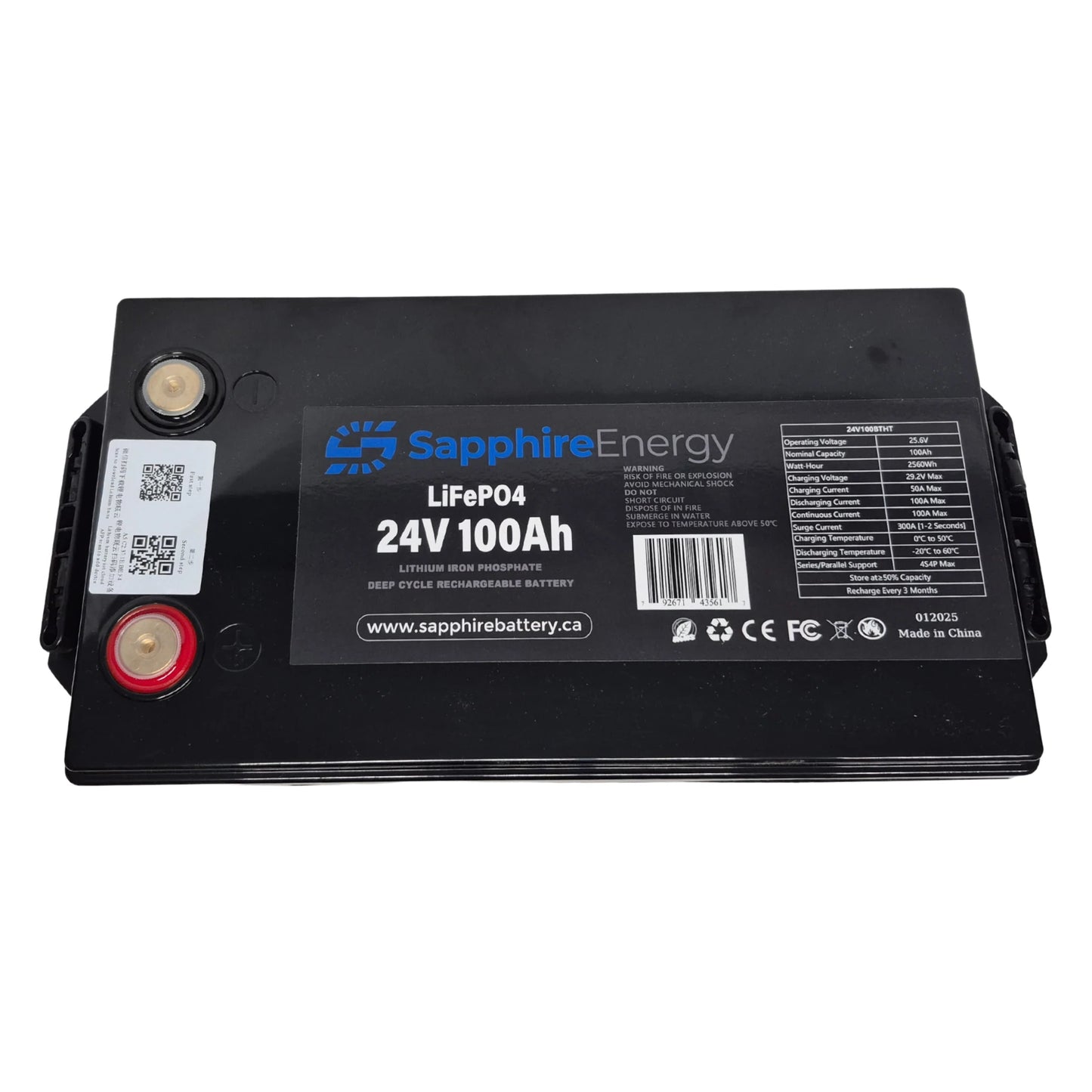
Why You'll Love It
| All-Season Power | Built-in 50 W self-heater warms cells to +5 °C before charging, enabling safe charging when ambient temps are below 0 °C. | ||
| Bluetooth Control | Monitor SoC, voltage, current, temperature, cell balance, and alerts in real time via the mobile app (Bluetooth 5.0). | ||
| Portable Power | Only ~41 lb with ~2,560 Wh energy and 100 A continuous output (≈2,560 W)—ideal for high-demand 24 V systems and larger inverters. | ||
| Easy to Scale | Link up to 2 in series (48 V) or up to 4 in parallel for extended runtime—flexible growth path for your system. | ||
| Built to Last | A+ LiFePO₄ cells rated 5,000+ cycles (at typical DoD) with robust BMS protections; IP65-rated enclosure for added durability. | ||
| Warranty & Support | Backed by a 5-year warranty and Canadian-based support for confidence on day one—and beyond. |
Power You Can Count On — Anywhere
Built with A+ grade lithium iron phosphate cells, this battery offers exceptional performance, safety, and longevity — delivering over 5000 cycles at 80% depth of discharge. Its advanced Battery Management System (BMS) protects against over-charge, over-discharge, over-current, short-circuit, and temperature extremes, so your investment stays protected.
Cold-Weather Ready
Equipped with a 50 W self-heating system, the 24V100BTHT can safely charge even in freezing conditions. When charging power is applied and cell temperatures are below 0 °C, the heater automatically activates, warming the cells to +5 °C before charging begins. No more worrying about winter storage or early-morning startups.
Smart Monitoring at Your Fingertips
Integrated Bluetooth 5.0 technology lets you track your battery’s status in real-time from your phone. View state of charge, voltage, current, cell balancing, and temperature — plus receive alerts before issues arise.
Serious Power for Serious Loads
With 2560 Wh of stored energy and a 100 A continuous discharge rating, this battery can run high-demand devices and large inverters. Perfect for powering 24 V solar setups, marine house banks, off-grid cabins, mobile workshops, or backup systems.
Lightweight, Durable, and Expandable
At just 41 lb, the 24V100BTHT is easy to handle thanks to its dual rope carry handles. The rugged IP65 case resists water and dust, making it ideal for harsh environments. Need more capacity? Connect up to 2 in series for 48 V systems or 4 in parallel for extended runtime.
Why Choose Sapphire Energy?
We design our batteries for long-term performance, maximum safety, and Canadian-backed support. Every battery is tested before shipping, and we stand behind the 24V100BTHT with a 5-year limited warranty and full after-sales service.
Applications
- RVs, motorhomes, and campervans (24 V house systems)
- Marine house banks for boats and sailboats
- Off‑grid cabins and tiny homes (24 V solar storage)
- Solar energy storage and hybrid inverter systems
- Backup power for homes, shops, and mobile businesses
- Mobile workshops and service vehicles
- Golf carts & low‑speed EVs using 24 V packs
Features
- Self-Heating Technology — Allows safe charging in sub-zero conditions; automatic 50 W heating element warms cells to +5 °C before charging begins.
- Bluetooth 5.0 Monitoring — View state of charge, voltage, current, cell balance, and alerts in real-time from your phone.
- High Capacity & Power — 100 Ah capacity (2560 Wh) and 100 A continuous discharge, suitable for large inverters and high-draw devices.
- Long Life — Built with A+ grade LiFePO₄ cells rated for 5000+ cycles at 80% depth of discharge.
- Advanced BMS — Protects from over-charge, over-discharge, over-current, short-circuit, high/low temperature.
- Expandable — Connect in series up to 2 batteries (48 V) or parallel up to 4 batteries for greater capacity.
- Weather Resistant — IP65 water and dust resistance for demanding environments.
- Portable — Dual rope handles for easy transport despite 41 lb weight.
- Warranty — Backed by a 5-year limited warranty for peace of mind.
Highlights
- Self-Heating for safe charging in sub-zero temperatures (≈50 W heater)
- Bluetooth 5.0 app monitoring — SoC, volts, amps, cell balance, alarms
- 100 A max continuous discharge • 2560 Wh capacity
- 5000+ cycles with A+ grade cells
- IP65 water and dust resistance
- Series up to 2S (48 V/51.2 V) • Parallel up to 4P
- 5-year limited warranty
Specifications
| Model | 24V100BTHT |
|---|---|
| Nominal Voltage | 25.6 V |
| Nominal Capacity | 100 Ah |
| Energy | 2560 Wh |
| Charge / Discharge Rate | 100 A max charge (50 A recommended) • 100 A continuous discharge |
| Maximum Inverter Load | ~2500 W continuous |
| Bluetooth | Bluetooth 5.0 monitoring (SoC, volts, amps, cell balance, alarms) |
| Self-Heating | 50 W heating; delays charging until cells ≥ +5 °C |
| Low-Temp Charge Cut-off / Restore | Cut-off: 0 °C • Restore: +5 °C |
| Low-Temp Discharge Cut-off / Restore | Cut-off: −20 °C • Restore: −10 °C |
| Protections (BMS) | Over-charge, over-discharge, over-current, short-circuit, high/low temp |
| Cell Grade / Cycle Life | A+ grade • 5000+ cycles |
| Configuration | Series up to 2S • Parallel up to 4P |
| Ingress Rating | IP65 |
| Handles | Dual rope carry handles |
| Dimensions (mm) | 385 × 192 × 260 |
| Dimensions (in) | 15.25 × 7.7 × 10.75 |
| Weight | 18.6 kg (41 lb) |
| Terminals | M8 bolts (included) |
| Warranty | 5-year limited |
Getting Started & Sizing
What size LiFePO₄ battery should I start with?
Easy first picks by use case:
• Budget/compact: 1280Wh — 12.8V 100Ah Classic
• More runtime: 2560Wh — 12.8V 200Ah Classic
• Winter & higher output: 2560Wh — 12.8V 200Ah Self-Heating Bluetooth (High Output)
• Longer runtime: 3840Wh — 12.8V 300Ah Bluetooth
New to sizing? How much battery do I need?
Can I replace my lead-acid battery one-for-one?
What inverter size pairs well with my first battery?
Why choose a single 24 V battery instead of 2×12 V in series?
• No pack-to-pack balancing — one case, one BMS, one Bluetooth connection.
• Simpler wiring — fewer cables, no series jumpers.
• Easier monitoring — one app (if Bluetooth).
• Lower current for the same power — slimmer cables and cooler-running inverters.
See our 24V 200Ah Self-Heating Bluetooth (High Output).
Charging: AC, Alternator & Solar
Do I need a charger made for LiFePO₄?
AC → DC charging (shore power or generator) — a dedicated LiFePO₄ charger converts household AC into a precise DC charge curve matched to lithium chemistry. If you’re plugging in at campgrounds, marinas, or with a small generator, this is the simplest route. Browse our LiFePO₄ Battery Chargers.
Solar charging — pair your panels with a solar charge controller that has a LiFePO₄ profile (or custom setpoints). The controller handles MPPT/PWM regulation and applies the correct voltages to protect the battery and maximize harvest. See our Solar Charge Controllers. If your controller offers user-defined setpoints, use the same 12 V targets above (bulk/absorb ~14.2–14.6 V; minimal/disabled float; no equalize).
Can I charge from my vehicle alternator?
Why Would I Need Self Heating?
Our Self-Heating batteries solve this by warming the cells automatically whenever charging is requested below freezing. The pack heats to a safe internal temperature, then begins charging—no manual steps. This is ideal for northern climates, winter activities (ice fishing, ski trips), vanlife, and outdoor storage where temps fluctuate. Adding insulation around the battery compartment helps it warm faster and reduces temperature swings for more consistent performance.
How much solar should I pair with a 12 V system?
Design rule of thumb (off-grid): 3 days of autonomy. That means sizing battery + solar so you can run for ~3 cloudy days without fully depleting the battery. If you also have alternate charging like a DC-DC alternator charger or occasional AC charger at campgrounds, you can safely reduce that autonomy target because you’re not relying on solar alone.
Step 1 — Calculate your daily watt-hours (Wh)
Make a list of devices: Watts × hours per day = Wh/day. Add them up.
Example day: LED lights (15 W × 4 h = 60 Wh), laptop (60 W × 3 h = 180 Wh), 12 V fridge (40 W avg × 24 h ≈ 960 Wh), phone charging (10 W × 2 h = 20 Wh). Total ≈ 1,220 Wh/day.
Step 2 — Size the battery bank
Battery capacity in Wh = Voltage × Ah. A 12 V 100 Ah LiFePO₄ ≈ 1,280 Wh, with ~80–90% usable = ~1,000–1,150 Wh usable. For 1,220 Wh/day and one day of autonomy, you’d look at ~12 V 200 Ah. For the full 3-day autonomy target, ~12 V 300–400 Ah (or a 24 V bank to reduce current).
Step 3 — Size the solar
Daily solar production ≈ Panel Watts × Sun-hours × system efficiency (efficiency often ~0.7 to include controller/battery losses). With 400 W of panels and 4 sun-hours: 400 × 4 × 0.7 ≈ 1,120 Wh/day—close to our 1,220 Wh example. If you drive daily with a DC-DC charger, you can rely on alternator charging to fill the gap and may choose fewer panels.
Be honest about heavy loads. High-draw devices (kettles, coffee makers, induction, space heaters) and large inverters increase both battery size and solar needed. Start small and expand as you confirm your real-world use.
For a deeper walkthrough, see How much battery do I need?, and explore Solar Products plus Charge Controllers.
Installation & Wiring
Can I connect multiple Sapphire batteries together?
Best practices: fully charge each battery before linking, use equal-length interconnects so currents share evenly, and match model/age/capacity. A Bluetooth model or a shunt monitor makes verification easy.
What wire size and fuse should I use?
Need parts? See Wiring & Accessories. For manuals and inverter/charger specs, visit Downloads.
Can I install my battery indoors?
Can I mount the battery on its side? Is the case weather-resistant?
Operation, Safety & Monitoring
Are Sapphire LiFePO₄ batteries safe?
How can I monitor health and state of charge (SOC)?
1) Shunt-based monitor (most accurate) — installs on battery negative and measures all current in/out to compute SOC, amps, Ah used, and time remaining. Our BM02 includes the shunt, an LCD, and a phone app. Wiring: battery negative → shunt → system negative, plus a small positive lead for the display.
2) Bluetooth batteries (fast & easy) — our Bluetooth packs report voltage, current, temperatures, cell balance, and BMS status in the app. A great example is the 12V 200Ah Self-Heating Bluetooth (High Output). Manuals and apps: Downloads.
Tip: Shunt monitors excel at accurate SOC over time; Bluetooth is great for diagnostics and cell-level detail.






